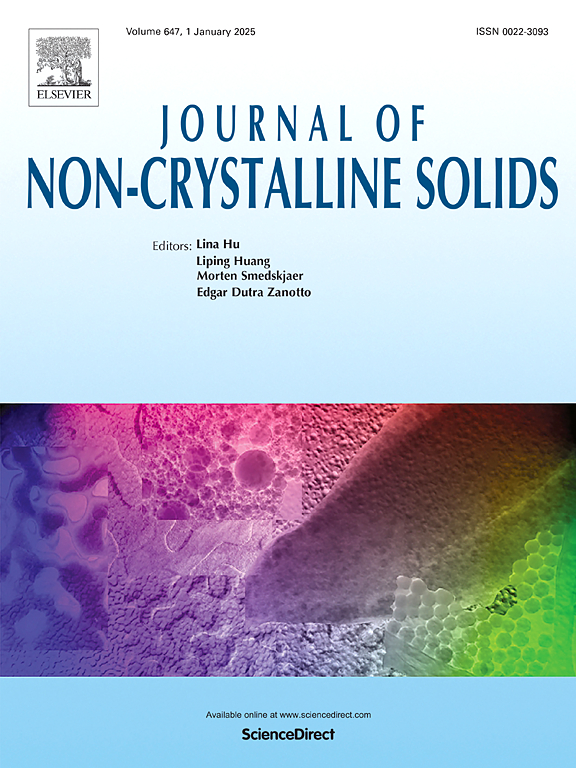在硼磷酸盐玻璃中添加ZrO2生物活性和力学性能的相互关系:体外研究
IF 3.5
3区 材料科学
Q1 MATERIALS SCIENCE, CERAMICS
引用次数: 0
摘要
本文研究了用熔体淬火法制备的40 B2O3 - 15 P2O5 - 20 CaO - (25-x) Li2O -x ZrO2(其中x (mol %) = 0.5、1、1.5、2)掺ZrO2硼磷酸盐玻璃的生物活性和力学行为。研究了在硼磷酸盐玻璃基体中加入ZrO2对其结构、物理、形态、力学和生物性能的影响。在FESEM图像中观察到的片状羟基磷灰石的形成证实了玻璃的体外生物活性行为。此外,XRD和FTIR结果表明,随着ZrO2含量的增加,玻璃基体的生物活性行为降低。测量了物理性质,如密度、摩尔体积和多余体积,以评估硼磷酸盐玻璃网络的变化。研究了添加ZrO2的硼磷酸盐玻璃的失重情况和模拟体液pH值的变化。力学性能评价表明,合金抗压强度范围为62.97 ~ 172.8 MPa,显微维氏硬度范围为4.36 ~ 5.7 GPa。玻璃的特定磨损是通过测量在针盘式装置的磨损过程中发生的重量损失来计算的。使用MTT法测试细胞毒性行为,结果表明MG-63细胞在浓度为200µg/mL时是活的。本研究清楚地表明,在硼磷酸盐玻璃基体中掺入ZrO2增加了机械性能,但牺牲了生物活性。本文章由计算机程序翻译,如有差异,请以英文原文为准。

Co-relationship between bioactivity and mechanical properties on addition of ZrO2 in borophosphate glasses: In-vitro studies
The present study endeavours toward the investigation on the bioactivity and mechanical behaviour of ZrO2 added borophosphate glasses having composition 40 B2O3 - 15 P2O5 - 20 CaO - (25-x) Li2O - x ZrO2 (where x (mol %) = 0.5, 1, 1.5, and 2) synthesized by melt quenching method. The effects of incorporating ZrO2 into borophosphate glass matrix on its structural, physical, morphological, mechanical, and biological properties were studied. In-vitro bioactive behaviour of the glasses was confirmed by the formation of flake-like hydroxyapatite as observed in the FESEM image. Additionally, XRD and FTIR results showed a decrease in bioactive behavior with increasing ZrO2 content in the glass matrix. The physical properties like density, molar volume, and excess volume, were measured to assess the changes in the borophosphate glass network. The weight loss of the ZrO2 added borophosphate glasses and the change in the pH of the simulated body fluid were also studied. The assessment of mechanical properties suggests that the compressive strength ranged from 62.97–172.8 MPa and the micro-Vickers hardness value ranged from 4.36 to 5.7 GPa. The specific wear of the glass was calculated by measuring the weight loss that occurred during abrasion wear on a pin-on-disc setup. Cytotoxic behaviour was tested by using the MTT assay, which shows MG-63 cells are viable up to a concentration of 200 µg/mL. The present study evidently shows the fact that the incorporation of ZrO2 in borophosphate glass matrix increases the mechanical properties at the expense of bioactivity.
求助全文
通过发布文献求助,成功后即可免费获取论文全文。
去求助
来源期刊

Journal of Non-crystalline Solids
工程技术-材料科学:硅酸盐
CiteScore
6.50
自引率
11.40%
发文量
576
审稿时长
35 days
期刊介绍:
The Journal of Non-Crystalline Solids publishes review articles, research papers, and Letters to the Editor on amorphous and glassy materials, including inorganic, organic, polymeric, hybrid and metallic systems. Papers on partially glassy materials, such as glass-ceramics and glass-matrix composites, and papers involving the liquid state are also included in so far as the properties of the liquid are relevant for the formation of the solid.
In all cases the papers must demonstrate both novelty and importance to the field, by way of significant advances in understanding or application of non-crystalline solids; in the case of Letters, a compelling case must also be made for expedited handling.
 求助内容:
求助内容: 应助结果提醒方式:
应助结果提醒方式:


